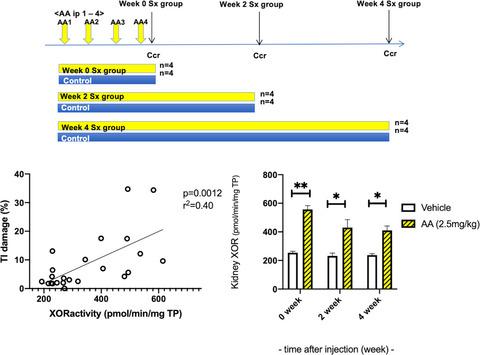当前位置:
X-MOL 学术
›
FEBS Open Bio
›
论文详情
Our official English website, www.x-mol.net, welcomes your feedback! (Note: you will need to create a separate account there.)
Tissue xanthine oxidoreductase activity in a mouse model of aristolochic acid nephropathy
FEBS Open Bio ( IF 2.6 ) Pub Date : 2021-01-15 , DOI: 10.1002/2211-5463.13083 Takeo Ishii 1, 2 , Tomohiro Kumagae 1, 3 , Hiromichi Wakui 1 , Shingo Urate 1 , Shohei Tanaka 1 , Eriko Abe 1 , Toru Suzuki 1 , Takahiro Yamaji 1 , Sho Kinguchi 1 , Ryu Kobayashi 1 , Kotaro Haruhara 1 , Takashi Nakamura 4 , Shuzo Kobayashi 1, 3 , Kouichi Tamura 1
FEBS Open Bio ( IF 2.6 ) Pub Date : 2021-01-15 , DOI: 10.1002/2211-5463.13083 Takeo Ishii 1, 2 , Tomohiro Kumagae 1, 3 , Hiromichi Wakui 1 , Shingo Urate 1 , Shohei Tanaka 1 , Eriko Abe 1 , Toru Suzuki 1 , Takahiro Yamaji 1 , Sho Kinguchi 1 , Ryu Kobayashi 1 , Kotaro Haruhara 1 , Takashi Nakamura 4 , Shuzo Kobayashi 1, 3 , Kouichi Tamura 1
Affiliation

|
Xanthine oxidoreductase (XOR) is a critical enzyme in purine metabolism and uric acid production, and its levels are reported to increase during stress, thereby promoting organ damage. Herein, we investigated the activity of XOR in a mouse model of aristolochic acid I (AA)‐induced nephropathy, a type of nephrotoxic chronic kidney disease (CKD). A persistent decrease in renal function was observed in mice up to 4 weeks after 4 weeks of AA (2.5 mg kg−1) administration. Renal histology revealed an increase in tubular interstitial fibrosis over time. Although AA administration did not change XOR activity in the plasma, heart, liver, or muscle, XOR activity was persistently increased in renal tissue. Our results suggest that the renal tissue‐specific increase in XOR activity is involved in the progression of tubulo‐interstitial disorders, specifically fibrosis.
中文翻译:

马兜铃酸肾病小鼠模型的组织黄嘌呤氧化还原酶活性
黄嘌呤氧化还原酶 (XOR) 是嘌呤代谢和尿酸产生的关键酶,据报道其水平在压力期间会增加,从而促进器官损伤。在此,我们研究了 XOR 在马兜铃酸 I (AA) 诱导的肾病小鼠模型中的活性,这是一种肾毒性慢性肾脏病 (CKD)。AA (2.5 mg kg -1 ) 4 周后,小鼠肾功能持续下降至 4 周) 行政。肾组织学显示肾小管间质纤维化随时间增加。尽管 AA 给药没有改变血浆、心脏、肝脏或肌肉中的 XOR 活性,但肾组织中的 XOR 活性持续增加。我们的研究结果表明,肾组织特异性 XOR 活性的增加与肾小管间质疾病的进展有关,特别是纤维化。
更新日期:2021-02-11
中文翻译:

马兜铃酸肾病小鼠模型的组织黄嘌呤氧化还原酶活性
黄嘌呤氧化还原酶 (XOR) 是嘌呤代谢和尿酸产生的关键酶,据报道其水平在压力期间会增加,从而促进器官损伤。在此,我们研究了 XOR 在马兜铃酸 I (AA) 诱导的肾病小鼠模型中的活性,这是一种肾毒性慢性肾脏病 (CKD)。AA (2.5 mg kg -1 ) 4 周后,小鼠肾功能持续下降至 4 周) 行政。肾组织学显示肾小管间质纤维化随时间增加。尽管 AA 给药没有改变血浆、心脏、肝脏或肌肉中的 XOR 活性,但肾组织中的 XOR 活性持续增加。我们的研究结果表明,肾组织特异性 XOR 活性的增加与肾小管间质疾病的进展有关,特别是纤维化。



























 京公网安备 11010802027423号
京公网安备 11010802027423号